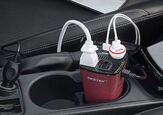Toyota Shakes up Lineup With New Engines, Transmissions, Hybrid Systems

(Update: Specifications for the 2.5-liter engine have been added.)
Dynamic Force. It sounds like the name of a military offensive from the early 2000s, but it’s also the name of Toyota’s next-generation gasoline powerplants.
The automaker has revealed the first of a slew of new engines that should power 60 percent of its vehicles within five years. Oh, and there’s new transmissions and hybrid components to go with them.
The first Dynamic Force engine is the replacement for the company’s stalwart 2.5-liter inline-four.
While metric displacement hasn’t changed, the wholly new mill adopts direct injection and a host of friction-reducing measures to achieve a thermal efficiency rating of 40 percent (up from the current 35 percent). This, plus high-speed combustion technology and a variable control system, boosts maximum output to 202 horsepower and 184 lb-ft of torque, up from the present 178 hp and 170 lb-ft. The 2.5’s compression rises to 13:1 from 10.4:1.
The 2.5-liter bound for hybrid models should make 174 hp and 162 lb-ft, and return a thermal efficiency of 41 percent. Compression tops that of the non-hybrid engine, at 14:1.
Toyota promises 17 variations of nine new engines between next year and 2021, with each mill finding a home in vehicles using the Toyota New Global Architecture (TNGA) platform. The first is likely the next-generation Camry bound for Detroit next month.
Joining the efficiency party are new Direct Shift eight- and 10-speed automatic transmissions. Toyota claims the transmissions — designed for less energy and friction loss — are lighter and more compact than before, allowing their use in a wider range of vehicles. The 10-speed, however, is only for rear-drive platforms. Together, the technological enhancements to these drivetrains should result a fuel economy boost averaging 20 percent.
Saddling a new engine with an old hybrid system would be foolish, so the automaker shaved weight and mass from its new Toyota Hybrid System II and Multistage THS II units. It also claims to have improved acceleration and high-speed fuel economy. Because the TNGA platform frees up extra space for batteries, future plug-in models should boast an improved all-electric range of 60 kilometers (37 miles) or more.
[Image: Toyota]

More by Steph Willems
Latest Car Reviews
Read moreLatest Product Reviews
Read moreRecent Comments
- The Oracle Good pick by Tim in terms of platform - he doesn’t pick the prices.
- MaintenanceCosts The Allison product that ought to be in these trucks is a scaled-down version of this. It works amazingly in use cases far more brutal than anything a pickup truck is ever subjected to. The agency I used to work for recently retired a fleet equipped with the first generation of the system after 20 years and nearly a million city miles each, with very few system failures.
- Jkross22 Looks like a Buick Envista up front and a Model 3 at the back. It's not bad, but is too derivative.The inside? Volvo/Polestar said they didn't want anyone dying in their cars after 2024. Sure seems like they're trying to kill as many of their buyers as possible by distracting them with this nonsense. Seriously.... do any UI infotainment/screen engineers test these things while driving, or just on the workbench?
- Tane94 The commercials with smarmy Joe Isuzu ( actor David Leisure) were epic and hysterical. "You have my word on it" was his catchphrase to the outlandish claims he made.
- Mitchell Leitman Matt, Canada is getting the EV5 as well. Looks like Kia likes Canada


































Comments
Join the conversation
I really like the current Toyota drive trains. They are bulletproof. I have a Camry Hybrid and I average north of 42 MPG. I drive normally, although in the slow lane. I will skip the new Toyota's for a while ... I do not want to have any problems with new power train designs. However, Detroit engineers will be freaking out. They are still trying to match the current Toyota drive train. What Detroit should do is cut engine and transmission engineering, then purchase drive trains from the Japanese. Imagine a Ford Fusion with a Camry Hybrid drive train. I would buy that one.
I greatly respect Toyota's focus on long term drivetrain durability but these are still complex engines with two types of fuel injection. I have hopes for the Freevalve technology mentioned here last week that seems to solve many challenges inherent in trying to squeeze efficiency and cut emissions out of engines. It will have to prove durable but it seems a pretty elegant solution.